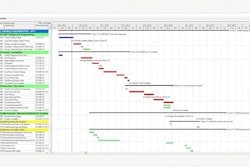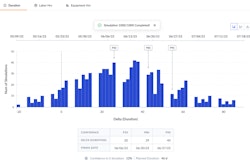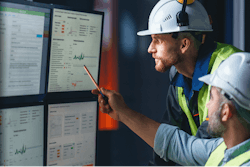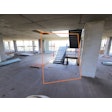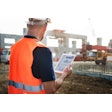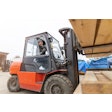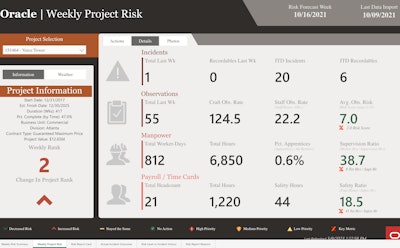
Enterprise resource planning (ERP) software giant Oracle is embedding dedicated AI tools to identify and mitigate construction safety risk in their construction software portfolio.
The enterprise software giant in 2022 purchased Newmetrix, and now that AI-driven construction safety software application will be interwoven with Oracle’s construction software products Aconex, Primavera and soon other applications in the Oracle Construction Intelligence Cloud.
Newmetrix was founded in Cambridge, Ma. In 2015 as Smartvid.io, which initially sought to help construction teams manage, collaborate and analyze industrial videos and photos to support project tracking, inspections and site assessments—even marketing. As time went on, the focus tightened to safety, with early use cases with major contractors like Skanska.
Newmetrix grew to middle market size before the acquisition, with a handful of sales reps and customer success professionals. Post-acquisition, Newmetrix is a standard Oracle SKU that contractors can acquire through Oracle Construction and Engineering sales representatives and channel partners. IRONPROS debriefed former Newmetrix CEO and current Oracle Senior Director of Product and Strategy for Construction Intelligence Cloud Josh Kanner in December of 2023.
“We are a part of the broader Oracle Construction Intelligence Cloud analytics and AI team,” Kanner said. “The vision at Oracle is to provide AI and analytics across the key areas of construction delivery risk, from safety to schedule to cost to quality, helping contractors and owners reduce risk and improve their overall project portfolio performance.”
READ THE IRONPROS DEEP DIVE ON ORACLE CONSTRUCTION INTELLIGENCE CLOUD
Kanner has founded other companies that have been acquired by IBM and Autodesk and has come to appreciate the added breadth of an enterprise organization, which in this case gives existing customers an enterprise-level customer success and support organization and stable, secure provisioning on the Oracle Cloud Infrastructure.
“We have now trained up the Oracle customer success team,” Kanner said. “And some Newmetrix customer success folks have come across as well … It's great to be a part of that bigger team. I’ve been in a couple acquisitions before and it's always it's always great to come in as a part of a broader work, especially when the visions are so well aligned like they are with Oracle.”
Construction Safety AI on OCI
Becoming part of Oracle has increased the total number of customers the Newmetrix technology can reach, and deep integrations are designed to make it into a core benefit of a broader application set. While the full scope of Oracle’s plan for its new construction safety AI analytics technology is yet to be made public, we are able to share some insights.
“Most recently, the Newmetrix platform, as it exists today, went through an Oracle security, audit and update process,” Kanner said. “And as a result, is now available as of October through Oracle Systems as a formal Oracle product. That was a big milestone for us ... The next big milestone is going to be next year, where the Newmetrix product is going to be relaunched within Oracle's OCI—Oracle Cloud Infrastructure—as a part of the broader Construction Intelligence Cloud.”
Oracle has made substantial investments in OCI’s ability to support the most demanding AI applications. In September at Oracle Cloudworld in Las Vegas, Oracle announced that Oracle Database 23c will support AI vector search. According to an Oracle release, this will “enable the Oracle Database to store the semantic content of documents, images, and other unstructured data as vectors, and use these to run fast similarity queries. These new capabilities also support Retrieval Augmented Generation (RAG), a breakthrough generative AI technique that combines large language models (LLMs) and private business data to deliver responses to natural language questions. RAG provides higher accuracy and avoids having to expose private data by including it in the LLM training data.”
RAG has been praised for increasing security of LLMs, reducing “hallucinations” or confabulatory responses, but by extending an enterprise database for AI brings additional benefits.
“Oracle Database is the leading repository of business data, and the combination of business data and semantic data is what enterprises need to implement artificial intelligence solutions,” Oracle Executive Vice president, Mission-Critical Database Technologies Juan Loaiza said in the release. “Searches on a combination of business and semantic data are easier, faster, and more precise if both types of data are managed by a single database. By adding AI Vector Search to Oracle Database, we enable customers to quickly and easily get the benefits of artificial intelligence without sacrificing security, data integrity, or performance. Using Oracle AI Vector search does not require machine learning expertise. All database users, including developers and administrators, can learn to use it in less than 30 minutes.”
From a raw compute power standpoint, Oracle also offers the OCI Supercluster AI Infrastructure, which is engineered specifically for demanding AI applications including computer vision, natural language processing and recommendation systems.
“Oracle OCI is built in a very modern way with a memory architecture, which allows us to do virtual clustering for AI,” Kanner said. “They've called for GPU (graphical processing unit)-based machines, which are basically hive memory-based transaction machines that are used in AI. You'll hear Larry Ellison talk about the fact that we're winning business like Uber. And actually, Elon Musk, just for X just bought a massive amount of capacity because of the advantage that OCI has over the other hyperscalers in the area of AI from a cost and performance standpoint.”
Safety AI with Project Management Software
This move will bring benefits to existing Oracle construction customers who gain the Newmetrix safety AI toolset, and to Newmetrix and its existing customers that get new capabilities through integration and bulletproof provisioning as the solution moves from Amazon Web Services (AWS) onto OCI.
“We integrate directly with Oracle products like ACONEX, as well as other construction management products—wherever safety related data might lie,” Kanner said. “And we pull that in through our pre-built integrations that can include safety observation data, safety checklist data—all kinds of structured data. We also pull in progress photos that might be gathered in the field from progress walks. We use all that to build our predictive analytics models for predicting safety risk.”
While Newmetrix can ingest and produce insights from photogrammetry and regular photographs, it is agnostic with respect to what hardware generates the images—which distinguishes it from camera system-based machine vision that may be able to identify safety issues.
“We actually don't require cameras or any kind of photography at all,” Kanner said. “If you have it, it's great. It helps with the predictive lift in our predictive models, but it's not required.”
Rather, Newmetrix can access a broad spectrum of project documents to extract predictive safety insights, both inside and outside of the Oracle family of software.
“If you have a project list, and you have observation data, and you've got incidents and near misses, that's a great starting place for the journey to use data to help measure and manage safety in a predictive way,” Kanner said. “One of our core philosophies is that we go get the data where it exists. You might have schedule data with activities in it. You might have manpower data in your field reporting system, that tells you different types of manpower on site and the hours they're there. We'll go get it and we'll try and make it work. That's actually a part of our service—something we call a predictive data assessment, which is a way we go in and work with a customer to assess their data. In essence, we look at what ingredients do they have in the pantry, their data pantry, and see what of those ingredients we can use to build either a benchmarking or predictive analytics approach for safety for them.”
The software automatically transforms the project data into the standard Newmetrix data model for predictive analytics. This requires, according to Kanner, 18 to 24 months’ worth of data.
Customers can harvest these insights from within a web interface, they can use the Computer Vision API to port them into other business intelligence applications.
“Once we've done what we do, it's ready to be consumed,” Kanner said. “It's either being consumed by someone in our UI, or in some kind of business intelligence UI.”
When used to send data out through APIs to other systems, Newmetrix is more akin to an AI-as-a-service tool than a system of record because it accesses data, transforms it and then relays it to other systems to be actioned.
But in many cases, the data may be going to other products in the Oracle construction portfolio.
“One of the exciting things for Newmetrix is to be a part of the broader Construction Intelligence Cloud. We are the safety predictive engine,” Kanner said. “The Construction Intelligence Cloud works with the other Oracle solutions like Oracle Primavera, the scheduling platform ACONEX, which is a document control and construction management platform unifier for capital programs, and Textura for payments.”
Apart from Oracle solutions, Newmetrix customers will find pre-built integrations with Autodesk, Procore, SharePoint and for 360-degree imagery, DroneDeploy. As part of Oracle, Newmetrix can harness the power of Oracle Integration Cloud (OIC), an integration platform-as-a-service technology.
“It has a whole bunch of out-of-the-box, pre-built adapters plus an integration framework for adding new ones,” Kanner said. “So that's actually part of what's happening with our product. It's being built into the whole Oracle stack, so we'll have the ability to use OIC.”
The move into OCI should have no noticeable immediate impact for customers already running Newmetrix.
“The move onto Oracle paper, to be an Oracle SKU, has been in the works for a while,” Kanner said. “There's really no day-to-day impact on customers there. And then the move to Oracle Cloud Infrastructure is going to open up a bunch of new opportunities for our customers, particularly around the broad this broader vision of all the different categories of risk and how AI can help manage them.”
Newmetrix Pricing and Market
Oracle enterprise software like enterprise resource planning (ERP) or enterprise asset management (EAM) will cost millions and be appropriate primarily for only the largest construction entities. Thanks to packaged integrations, Newmetrix will be a fit well into the middle market, however.
As is often the case, Newmetrix pricing harmonizes with strategies of other products in the solution for both project-specific and enterprise pricing.
“Like ACONEX, it's percent of project value,” Kanner said. “It's a project value analysis that scales with the size of the deployment. At the enterprise level, it’s volume-based pricing based on a company’s total construction value, which includes unlimited users and unlimited data.”
The smallest of users may be looking at a total cost of thousands of dollars a year, with the largest investing hundreds of thousands per year, according to Kanner.
The cost is offset though by reductions in hard and soft costs.
“Leading contractors use our solution because they want to get a lot better,” Kanner said. “They tend to be very high performing on the safety side, and they want to add additional capability and reduce their total recordable incident rate even further. But the other end of the of the barbell is our companies that are looking to improve as well like, because they realize that safety is something that they should focus on.”
According to the Workplace Safety and Insurance Board, the average cost of one lost-time injury on a job site is $35,000.
“The benefits of reducing your recordable incident rate are both financial and cultural,” Kanner said. “On the financial side, every incident you avoid is $50,000 or more in direct costs, some would say it's up to 10 times that, because you may have a significant productivity loss, when you have an incident on your job. Your TRR reduction translates into savings on insurance. We did a webinar recently with Boldt, one of our customers, and they reduced their workers compensation expenses by 75%.”
BOTTOM LINE: There are a few takeaways from what’s going on with Newmetrix. The first is that as the construction software sector experiences merger and acquisition activity, this can be a win-win for startups and their customers. The other salient point is that while construction safety technology is burgeoning, from cameras to Bluetooth and cellular data-driven applications and more, the compute power to draw inferences and identify opportunities to improve will now become critical. Large contractors may run AI pilots internally or develop homegrown systems, but in the overwhelming majority of cases it will be hard to argue with the value proposition of packaged software capable of AI-driven analysis of mission critical safety data.
